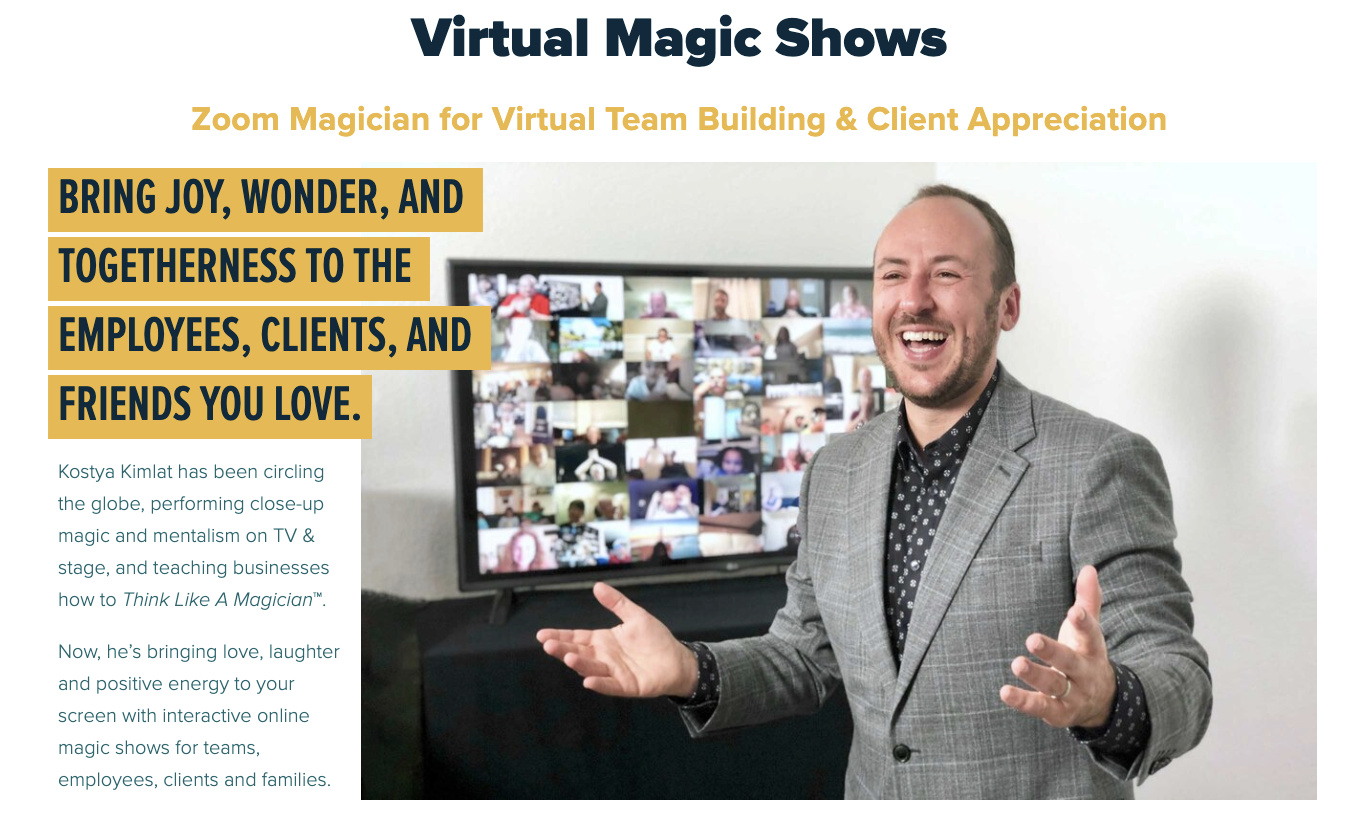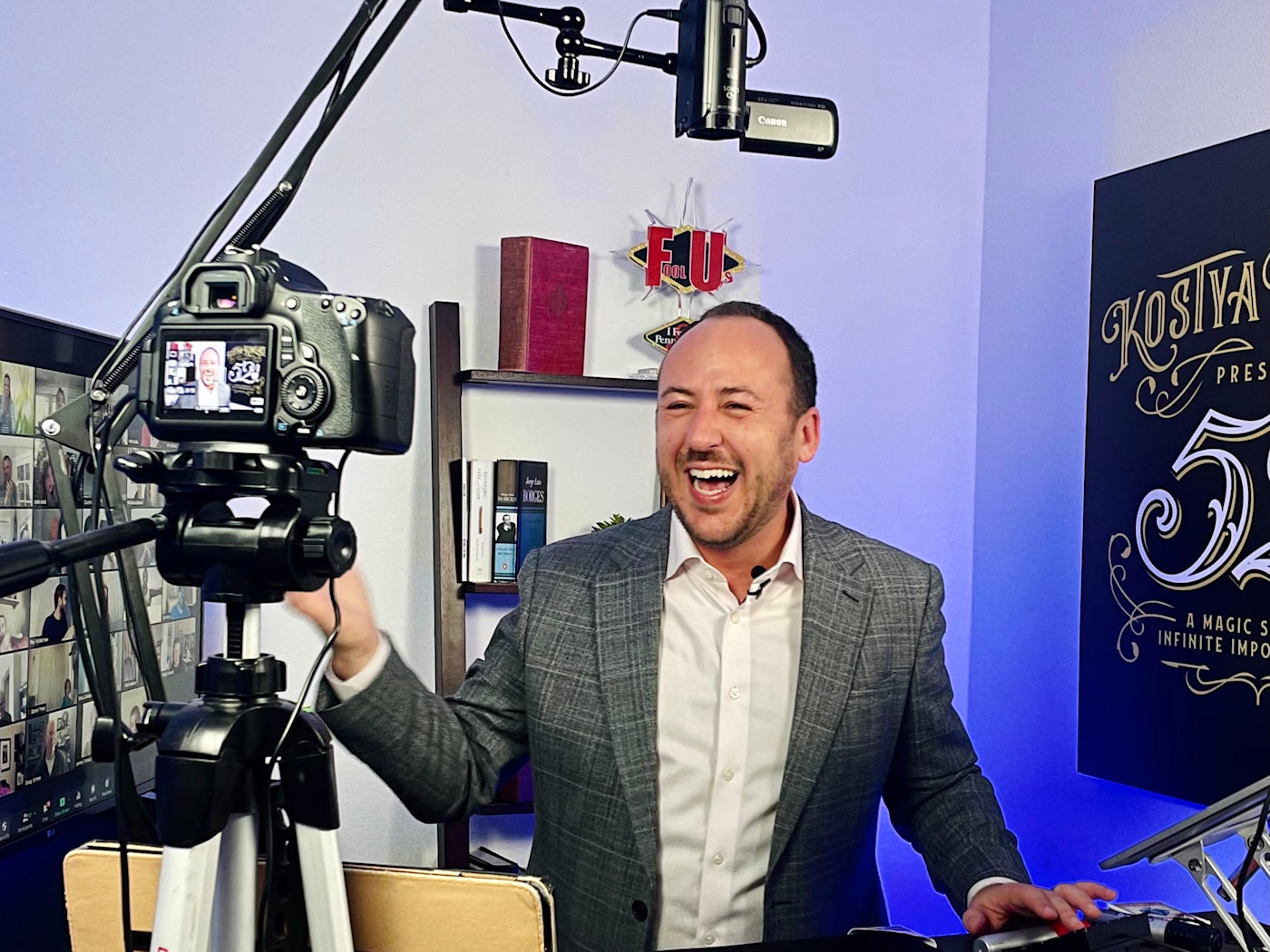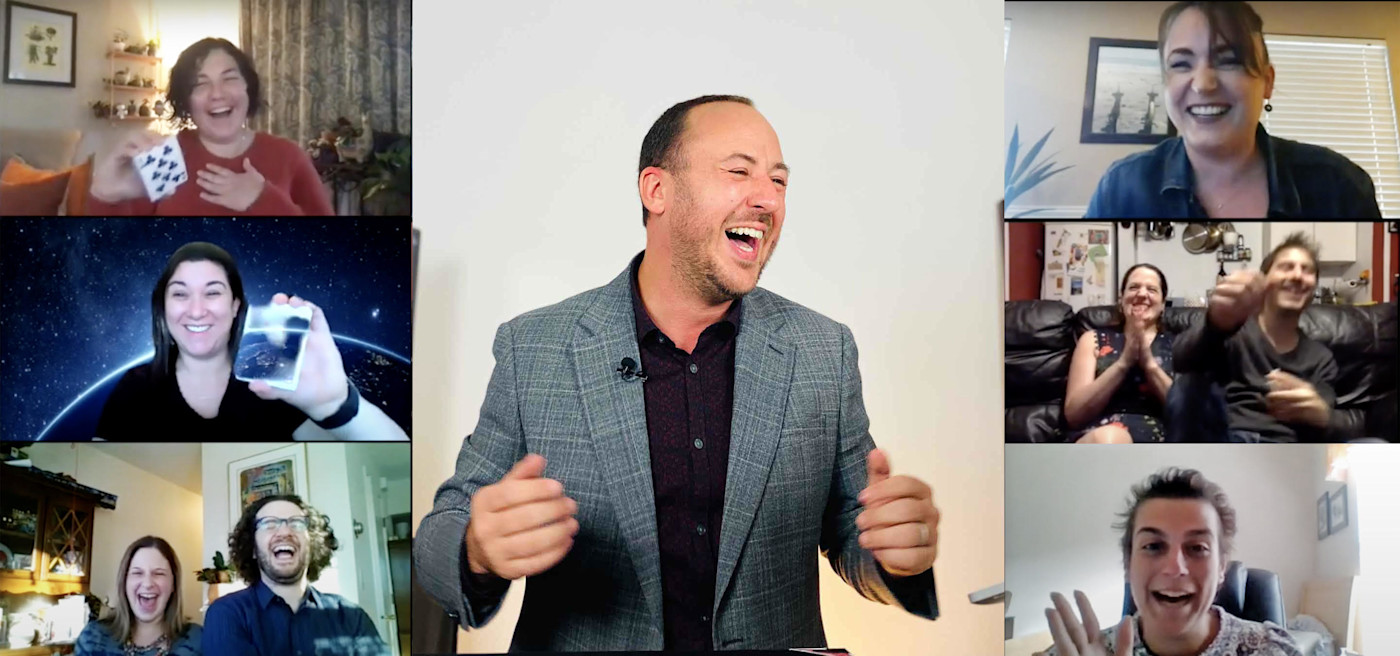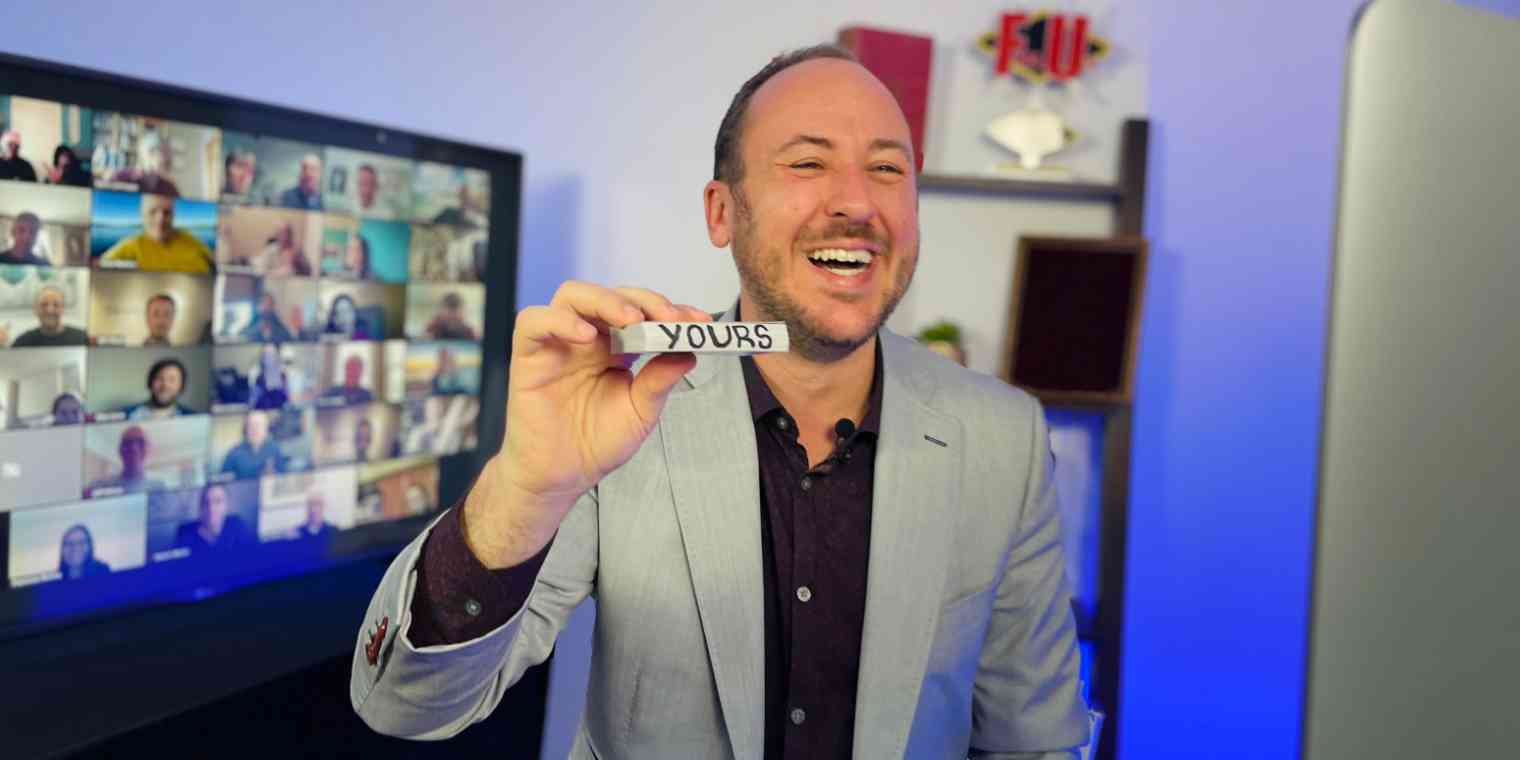In March 2020—like the worst magic trick ever—all of my magic shows, keynote speaking presentations, and basically my entire business, disappeared overnight. Like many other small business owners, my wife and I busily prepared for the pandemic-generated draught of meetings and conferences by cutting our business expenses by 80%.
Before the end of the month, though, one of our clients had called to request that I perform a magic show for her company virtually—and a new business was born.
Throughout the course of the year, my wife and I steadily built our new virtual operation. By the end of the year, we'd achieved the best business year in my 20+ years as a professional magician.

The key to our success was using a different way of thinking. As a motivational speaker, I teach people how to Think Like A Magician™. So when we set out to create this new virtual magic show business, we implemented these same principles of how magicians think, which I've been teaching business professionals for two decades.
Here are three strategies that made the biggest impact on our business and transformed an uncertain moment into a magical opportunity.
Step inside the mind of your audience
In order for a magic trick to be successful, a magician must understand how the effect is perceived from the eyes of its audience members. You have to know what your audience knows.
Some of the world's simplest magic tricks can blow an audience away—just because the audience lacks the basic knowledge of how the trick works. For a trick to be fooling, the magician just needs to be one step ahead of what the audience knows and sees.
Staying one step ahead of my clients helped fuel my business growth. When I talked to my clients about their upcoming virtual events, I discovered that there was a wide range of knowledge and comfort with event production technology. Different clients were impressed by different things.
For those clients who had never hosted a virtual event, I emphasized that I could take care of everything for them—including the virtual production and technology.
For those companies who had already hosted virtual events, I demonstrated how I could provide a memorable and unique experience.
And for those businesses who had been working remotely already for years, I showed them what the next level of interaction and team-building could look like.
Whether you're looking at your product or your promotions, don't try to do the same tricks for every audience. Sometimes your most impressive "tricks" won't be appreciated, while something that is very simple for you to execute may be the thing that astonishes your customer.
Ask yourself these questions to think about your audience's perception:
What is the range of knowledge that my various audience members (customers) have?
What does my audience already know about my product or service?
What is something that will surprise my audience simply because they haven't seen it before?
Conjure the effect you want your audience to perceive
Magicians love to say that they make the impossible possible. This is a big lie. What they really do is make the perception of the impossible possible. They don't really cut someone in half and put them back together. They don't really levitate. But they can convince you fully that is exactly what you're seeing.
The reason that magicians are so good at this is that they first ask themselves, "what is impossible?" Good magicians don't initially worry about how this will be achieved. This thinking process allows magicians to create the ultimate effect—which is the perceived experience that the audience is going to have.
While this is a simple secret, this is the concept that I most often deliver as a motivational speaker at business meetings—helping companies identify their ultimate effect. Your effect is different from your mission, your vision, or your "why." That's because your effect exists solely and completely in your audience's mind.
When I was delivering my in-person keynote presentations, my effect was transformation. At the end of any speech, I wanted my audience to look at their job or business in a whole new way.

But in the virtual world, I realized I was delivering a different effect of great importance: community. Because I realized my new effect, I was able to use the effect of community as a guidepost every step of the way. Every interaction and moment of my virtual magic show focused on maximizing the feeling that we're all connected. That feeling could be created
verbally, by acknowledging the people in the room;
visually, by using technology to highlight audience members and show the gallery view throughout the experience;
and physically, by getting everyone to participate in a magic trick with items from their homes or a special package that was sent to them.
The response was instant, as my clients would tell me that this was the first time they'd felt meaningfully connected since the start of the pandemic. Knowing that my effect was so strong, we integrated the language of community into all of our marketing and sales efforts.
Ask yourself these questions to clarify your effect:
What does my customer perceive when they think of my product, service, or brand?
What is an effect that would make a meaningful impact on my customer?
If method wasn't a concern, what would be the most amazing effect I could create for my customer?
Astonish your audience
When a magician performs a magic trick, they first need to set clear expectations, so that the audience can imagine what incredible effect is about to occur. This is what happens when the magician says, "wouldn't it be amazing if…" and sets up an impossible premise. This raises anticipation and gets the audience to focus all their attention on the present moment. It's essential to great magic.
But the best magicians have an extra trick up their sleeves beyond fulfilling expectations. This is what we call a "kicker ending." Not every trick has a kicker ending, but some of the most memorable ones do, and they're especially powerful tools for experienced audiences who think they know what's coming. They're a great way to astonish repeat audiences.
As I pivoted my business to the virtual world, I knew that I had to deliver an excellent virtual magic show of the highest quality to my high-paying corporate clients. That's what they expected. But I also knew I had to apply this same principle in my business to add an extra moment of wonder.

So at the end of my virtual magic shows, as a surprise kicker ending, I began to teach my audiences how to perform one particular magic trick that first got me hooked on magic. Through teaching this trick, I empowered my audiences with the ability to create a moment of magic for anyone else in their life. It extends the memory of the show and gives my audiences something really exciting to talk about long after the live experience is over.
Ask yourself these questions to help you astonish your audience:
What expectations can you set that you know you can deliver on 100%?
How can you make it clear to your customer that you have delivered?
What unique and memorable surprise can you add on as a kicker ending to a successful transaction?
Go forth and create magic in your business
Transforming our business from in-person to virtual wasn't effortless or magical. We had to rethink what we offered, how we offered it, and why we offered it. We succeeded in our virtual pivot because we applied all three strategies that I teach to my clients.
We were willing to see things from our audience's new perspective, we considered how we could most impact them, and we thought through their journey from start to finish to maximize anticipation and strengthen the memories that would remain.
To Think Like A Magician™, you don't have to make the impossible possible. You have to understand what your audience thinks is impossible and make that happen for them. This doesn't require extraordinary powers or extrasensory perception. It requires a willingness to pay close attention and see things in a way you haven't seen them before. That's where you'll find the magic. Learn more at KostyaKimlat.com.
This was a guest post from Kostya Kimlat, a magician and motivational speaker who teaches businesses, organizations, and associations to Think Like A Magician™ at live in-person conferences and virtual meetings. Kostya has also presented his virtual magic show for thousands of professionals around the world through the magic of Zoom. Invite Kostya to speak to or perform for your business team or association here. Want to see your work on the Zapier blog? Read our guidelines and get in touch.





